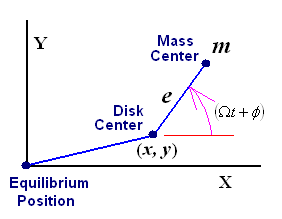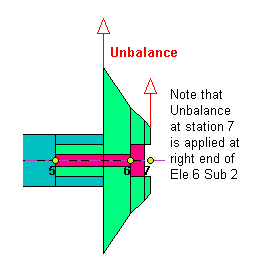
The mass unbalances of a rotating assembly are usually determined by using the multi-plane balancing machines. These mass unbalances are discrete and located at different planes with a magnitude of (mass * eccentricity). The unbalance planes may be located at the ends of each subelement in this program. These unbalance forces are assumed to be discrete and independent. Multiple unbalances are allowed at the same location.
For a mass unbalanced disk at station i with an unbalance me, this unbalance can be placed at the left end of element i with a magnitude of me. However, precautions must be taken for the unbalanced disk located at the right end (last station) of each shaft. Since there is no element number corresponding to the last station number on a shaft (explained in the Shaft Elements), this unbalance can be placed at the right end of the last subelement.
1. Ele: Element number.
2. Sub: Subelement number.
3. Type: Two types of synchronous unbalance excitations are allowed.
0 – Typical mass unbalance force, the mass unbalance force is (me x speed^2).
The data input for the amplitude is me (mass x eccentricity) without speed component.
1 – Constant magnitude synchronous excitation, this can be due to many other sources, such
as magnet force in the motor, etc.. The amplitude of this synchronous excitation is a
constant and independent from rotor speed. The data input for the amplitude is Fo.
4. Left Unb Amp.: Left end unbalance amplitude (me or Fo).
5. Left Ang: Left end unbalance phase angle measured from X-axis (degree).
6. Right Unb Amp: Right end unbalance amplitude (me or Fo).
7. Right Ang: Right end unbalance phase angle.
8. Comment: Description.
The unbalance force is represented by an arrow vector in the mass model. In the right bottom of the screen, the proper units for the specified unit system are displayed for reference. Some commonly used unit conversions for type 0 are listed for reference. For type 1, the unit for amplitude is force (Lbf or Newton).
1 g-in = 0.03527 oz-in
1 oz-in = 28.35 g-in




Copyright © 2014-2017